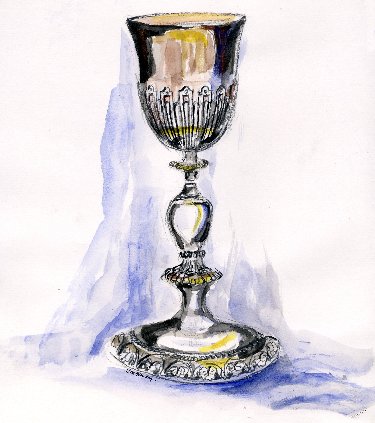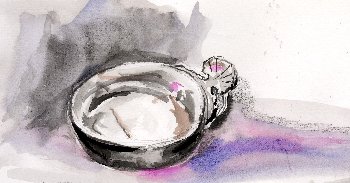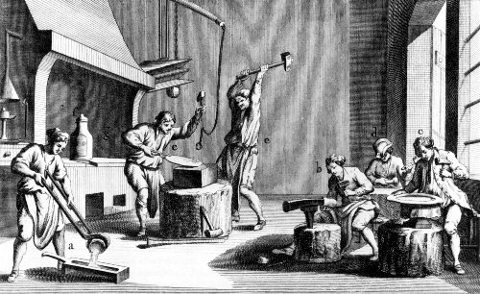Silversmiths & the Glory of New France
by Jennifer McKendry©
detail of a silver ciborium, Quebec, c1735 |
|
Shimmering in the soft brilliance of candles, the precious church silver, the ciboriums, the monstrances, the chalices, and the processional crosses played a mystical role in the timeless rites of the religion of New France. Wrought in beauty to house the blessed wine and wafers, their changing, reflecting surfaces seemed appropriate to the drifting incense burning in the censer and the familiar Latin chants of the priests in the carved and gilded church interiors.
silver chalice by Charles-Cesar Haudry, 18th century, Quebec; painting by J. McKendry© How it must have brought home to the First Nations converts of the seventeenth century the awesome power of Louis Quatorze at the height of France’s glory. That royal profile echoed haughtily in the features of the Virgin and her Child in silvery baroque. Did the Hurons reach out to that statue for mercy, as they died of smallpox? The Baroque world of Colbert, LeBrun and Talon was served by the silversmiths of Paris, and the works that found their way to the colony were a source of inspiration for the silversmiths of New France in the eighteenth century. Out of the ranks of shoemakers and gunsmiths, colonial silversmiths were developed, even if they kept their hands in at another trade in case the silver market was not lucrative. Not until late in the nineteenth century did they discover silver deposits in Silver Islet, Lake Superior, and hence these delicate and robust objects had to be wrought from plebeian sources: foreign coins, old swords, and outdated cutlery. On the one hand, the government officials complained about the lack of currency in the province because of hoarding, but on the other they ordered lavish settings of silver to impress the seigneurs of the colony. Wine tasters and porringers now seem exotic furnishings.
silver wine taster by Ignace François Ranvoyzé (1739-1819); painting by J. McKendry© The silversmiths cast, beat and chased the malleable material into gracefully proportioned objects, ornamented with gadrooning, heavy scrolls and acanthus leaves. The light-hearted fantasies of the rococo period did not seem to touch them in the way that the majesty of Louis XIV did or the restrained lines of Louis XVI. The melodic names of the early smiths, Jean-Baptiste Deschevery dit Maison-basse, Paul Lambert dit Saint-Paul, Ignace François Ranvoyzé and Laurent Amiot seem to flow as easily as the sacred or profane wine did into the cups or chalices they produced.
goldsmiths at work in France during the 18th century (from Diderot's L'Encyclopédie of 1762-72) ____________________________________________________ A SELECTION of EARLY QUEBEC SILVERSMITHS: Laurent Amiot, 1764-1839 Nicolas Amiot, 1750-1821 George Bohle, 1831-69 Peter Bohle, 1786-1862 Michael Cotton, b1700- Robert Cruickshank, act c1773 -1809 Ignace-François Delezenne, 1717-1790 Michel Fortin (Forton), 1754-1817 Charles-Cesar Haudry Pierre Huguet dit Latour, 1749-1817 Paul Lambert, 1691-1749 Jean-François Landon, 1686-1744 Salomon Marion, 1782-1832 Paul Morin, 1775-1854 (act to1805) Jacques Pagé, 1682/6-1742 Roland Paradis, 1696-1754 Ignace-François Ranvoyzé, 1739-1819 François Sasseville, 1797-1838 Joseph Sasseville, 1776-1831 Jacques Varin de la Tour, act 1738-91 Joseph Varin dit Lapistole, c1745-1791 home page top of page antiques (list of internal links to articles on antiques) |



